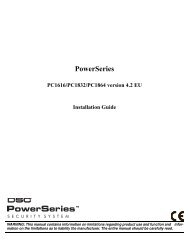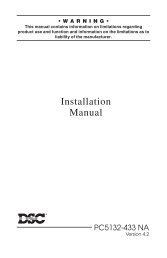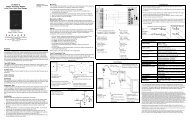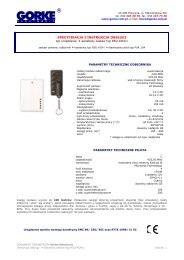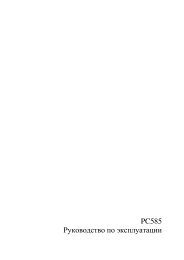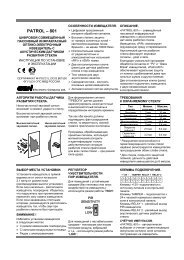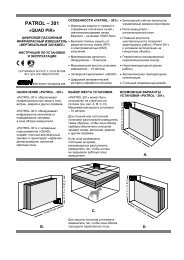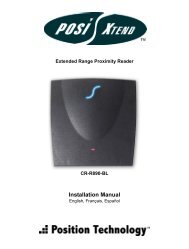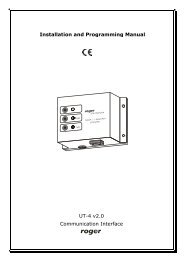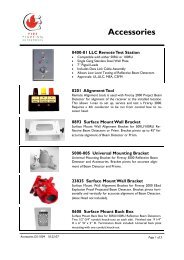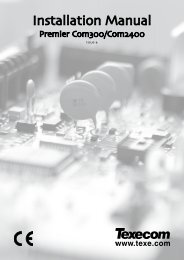CONVENTIONAL FIRE PANELS - Kotesa
CONVENTIONAL FIRE PANELS - Kotesa
CONVENTIONAL FIRE PANELS - Kotesa
- No tags were found...
You also want an ePaper? Increase the reach of your titles
YUMPU automatically turns print PDFs into web optimized ePapers that Google loves.
Extinguishment Module TerminalsEM Supervised/Bypassable Manual ExtinguishmentInputThis Input is for manual activation of the Extinguishmentdevices.Standby status of this Input can be either NormallyOpen (at default) or Normally Closed (refer to “ManualExtinguishment Input” under “Enrolling: ExtinguishmentModules” in the “PROGRAMMING FROM PC”)Operating principles: the Control panel will consider the EM Input OPENwhen a 3.900 ohm resistance is applied to its [+] and[–] terminals; the Control panel will consider the EM Input CLOSEDwhen one or more (up to 10) 680 ohm resistor is/areapplied in parallel to the 3.900 ohm resistance.The EM Input will activate when inverse conditions to itsstandby conditions occur.Activation of the EM Input will start the Pre-ExtinguishmentTime.Activation of the EM Input will be indicated by Glowingon the ON Manual Ext. LED.Short-circuit or power supply interruption on the EMInput will be indicated by fast blinking on the Fault ManualExt. LED.The EM input can be disabled by means of the DisableManual Extinguish. key.Disablement of this Input will be indicated by Glowingon the Disable Manual Extinguish. LED.IE Supervised Inhibit Extinguishment InputThis Input is for the inhibition of Extinguishment devices.The standby status of this Input can be either NormallyOpen (at default) or Normally Closed (refer to “DisableExtinguishment Input” under “Enrolling: ExtinguishmentModules” in the “PROGRAMMING FROM A PC”).Operating principles: the Control panel will consider the IE Input OPENwhen a 3.900 ohm resistor is applied between its [+]and [–] terminals; the Control panel will consider the IE Input CLOSEDwhen one or more (up to 10) 680 ohm resistor is/areapplied in parallel to the 3.900 ohm resistor.The IE Input will activate when the inverse conditions toits programmed standby conditions occur.Activation of the IE Input will start the Pre-ExtinguishmentTime.If the IE Input is active when Extinguishment conditionsoccur, the Control panel will activate the PR Output(Pre-Extinguishment) but WILL NOT START thePre-Extinguishment Time.If the IE Input activates during the Pre-Extinguishmentphase, the Control panel will stop Pre-ExtinguishmentTime. The Control panel will restart the Pre-ExtinguishmentTime when the IE Input restores to standby.If the IE Input is activated during the Extinguishmentphase, the Control panel will reset the EV Output (Electrovalve).The Control panel will re-activate the EV Outputwhen the IE Input restores to standby.Activation of the IE Input will be indicated by Glowing onthe ON Disab. Ext. LED.Short-circuit or power supply interruption on the IE Input willbe indicated by fast blinking on the Fault Disab. Ext.LED.PS Supervised Pressure Switch InputThis Input is for the Pressure Switch connection.Standby status of this Input can be either NormallyOpen (at default) or Normally Closed (refer to “PressureSwitch Input” under “Enrolling: ExtinguishmentModules” in the “PROGRAMMING FROM A PC”). the Control panel will consider the PS Input OPENwhen a 3.900 ohm resistor is applied across its [+]and [–] terminals; the Control panel will consider the PS Input CLOSEDwhen one or more (up to 10) 680 ohm resistor is/areapplied in parallel to the 3.900 ohm resistor.The PS Input will activate when the inverse conditionsto its programmed standby conditions occur.Activation of the PS Input will be indicated by Glowingon the ON Pres. Switch LED.Short-circuit or power supply interruption on the PSInput will be indicated by fast blinking on the Fault Pres.Switch LED.If the Pressure Switch Input of an Extinguishment Moduleis activated during or after the Extinguishment phase,and the respective Extinguishment Confirmation optionis ENABLED (refer to “Pressure Switch Input” under“Enrolling: Extinguishment Modules” in the “PRO-GRAMMING FROM A PC” section), the Control panelwill activate the AE Output (Activated Extinguishment).EV Supervised Electrovalve OutputThis Output is for the Electrovalve connection.Operating principles: in Standby status, the EV terminals will be OPEN; during the Extinguishment phase, the EV terminalswill be CLOSED.Activation of the EV Output will be indicated by Glowingon the ON Electrovalve LED.Short-circuit or power supply interruption on the EVOutput will be indicated by fast blinking on the FaultElectrovalve LED.Up to 5 A can circulate on the EV Output.24P Power Boost InputThis Input is for the Power boost required by the devicesconnected to Outputs PR and AE.Wiring instructions:Connect the [+] and [–] terminals of this Input to the [+]and [–] terminals 47 of the Switching Power Supply.PR Supervised Pre-Extinguishment OutputThis Output is for Pre-Extinguishment signalling.Operating principles Standby status: negative pull-down to 0 V on the [+]terminal; positive pull-up to 27.6 V on the [–] terminal. Pre-Extinguishment phase: positive pull-up to 27.6 Von the [+] terminal; negative pull-down to 0Vonthe[–] terminal.Activation of the PR Output will be indicated by Glowingon the ON Pre Ext. LED.Short-circuit or power supply interruption on the PR Inputwill be indicated by fast blinking on the Fault Pre Ext. LED.Up to 1 A can circulate on the PR Output.28 Conventional Fire Panels J424/J408




